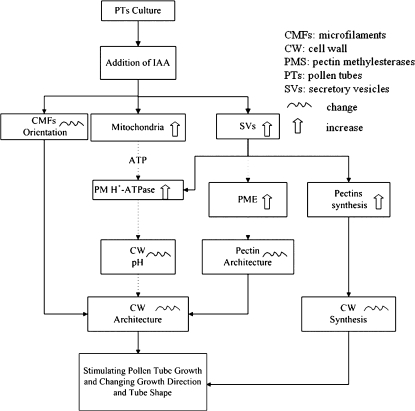Fig. 9.
A hypothetical model for the effects of IAA on pollen tube growth in Torenia fournieri. IAA stimulates the amount and activity of mitochondria and the secretion and fusion of SVs in the pollen tube, which transports more cell wall materials (such as pectin) and various enzymes (such as PM H+-ATPase and PME) into the tube tip. The increase in pectin indicates the enhancement of cell wall synthesis. The increased numbers of mitochondria support more energy (ATP) for various cellular activities such as the execution of PM H+-ATPase function. The increase in PM H+-ATPase results in a change in the pH condition of the cell wall, which may lead to the modification of cell wall architecture. The increase of PME activity stimulates the pectin de-esterification process and consequently causes the alteration in pectin architecture. IAA also induces reorientation of cellulose microfibrils in the tube cell wall, which results in modification of the cell wall architecture. Simultaneous cell wall synthesis enhancement and cell wall architecture modification lead to the promotion of pollen tube growth, accompanied by a narrower tube diameter and a straighter tube.

